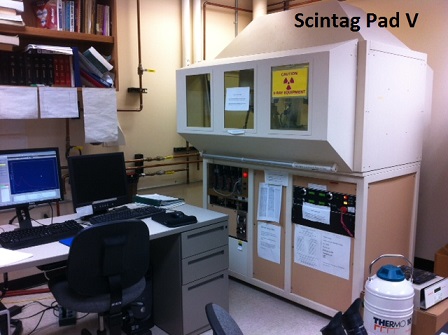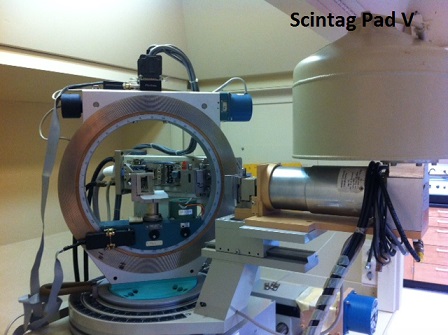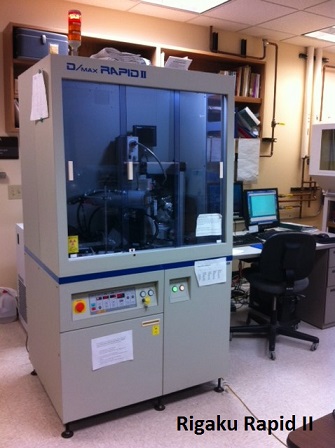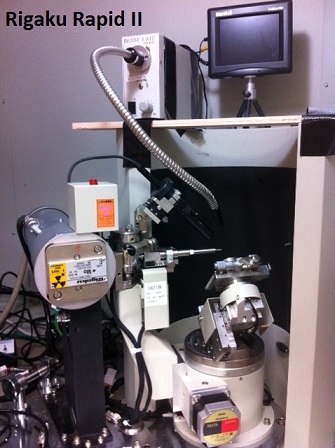The S.W. Bailey X-ray Diffraction Laboratory |
|
Room A353 Weeks Hall • (608) 262-0915 |
|
Lab Manager: Franklin Hobbs, E-mail: fhobbs@wisc.edu, (608)890-0928 (office), (608)262-0915 (lab)
Our facility is located in room A353 Weeks Hall. Campus researchers trained in the use of the instrument are encouraged to make
full use of the analytical capabilities and expertise offered by this laboratory at a modest rate.
We offer training in basic theory and technique. The beginner user may trained for Scintag instrument first,
and after Franklin or Huifang's permission you can take the second training session for to use Rigaku instrument.
Download a copy of our User's guide for Scintag (pdf) and
User's guide for Rigaku (pdf).
Sign up for time on the calender. Check out the scheduling rules.
Professor Huifang Xu (email) is in charge of the XRD lab and is assisted by Franklin Hobbs (email), phone: (608)890-0928 (office), (608)262-0915 (lab).
We installed a new Cu Ka X-ray tube (10-15-2013), rated at 2.0 KW. We intend to operate it at 45 kV and 40 mA (exceptions: previous users who wish to continue to run their samples at 40 kV and 35 mA will be permitted).
Service for our Scintag Pad V provided by Compass Engineering Company.


The Rigaku D/Max Rapid II diffractometer with a curved two-dimensional imaging plate (2D IP) is designed specifically for micro-area analysis. The Mo Ka X-ray tube operates at 50kV and 50mA (rated at 2.5 KW). The combination of 2D IP and the high intensity X-ray source gives increased diffraction X-ray intensity. Attached in situ device enables rapid measurements of the change in the crystal structure with phase transition as well as thin films analysis.


New Users: All new users MUST undergo training in order to use these diffractometers. While previous XRD experience on similar machines will facilitate your learning experience, the X-ray safety training and the training (1-2 hours) on the Scintag hardware and software is MANDATORY. All the new users should take the X-ray safety training (provided by the X-ray safety officer) and answer the quiz. The X-ray safety permission will be sent to those who passed the exam within a couple of days. Without the X-ray safety permission nor machine user permission, it is not allow to use any X-ray diffractometer in our lab. Only the advanced users may get trained for Rigaku diffractometer later. Violators of this rule will be denied further access to this facility, and responsible for penalty and all repair costs.
Please be on time for your training session. The training fee is still charged for the date/time scheduled.
Because of the university overheads, there are different rates for academic users and non-academic users.
XRD rate for Academic users
XRD rate for Non Academic users
Consultation and data analysis fee
Previously prepared samples may be run by us for individuals upon prior consultation. The standard price is $100/pattern including the sample setting, the XRD measurement, the data set and the data analysis. For the details pleasae contact to the lab manager.General use hours are Mon-Fri 8am-7pm, advanced users may use the XRD after hours. No one may use the XRD overnight (10pm-7am) without permission from Franklin or Huifang. No one may use the XRD on the weekend (10pm Friday night - 6am Monday morning) without our permission.
Please be on time for your session! We have many users competing for time and the schedule fills up quickly. If no one is using the instrument 20 minutes after a scheduled session, that time is then freely available. Therefore, if you are more than twenty minutes late for your session, you may lose your time. For booking your experiment for both Scintag and Rigaku (only advanced users with permission) please use the schedule with the username and password provided after your training session.
SoftwareMDI DataScan4, RINT RAPID, JXG, 2DP, JADE (for phase identification and quantitative analysis), PDF-4 (powder database, full set)
Analytical capabilities of the XRD lab:
Powder Diffraction: Particle sizing, Strain analysis, Phase identification, Structure refinement, Quantitative phase composition, Lattice parameter determination, Characterization of amorphous components, Pole Figures Texture (preferred orientation), Single crystal orientation determination, Bicrystal orientation determination.
See the detail applications (download pdf)
Links to XRD resources:
There are couple of great resource to provide you the background knowledge of XRD. Books are available at the geology library. Links to XRD resources are below.